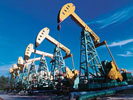ID :
233639
Fri, 03/23/2012 - 09:56
Auther :
Shortlink :
http://m.oananews.org//node/233639
The shortlink copeid
Volume of oil production in Azerbaijan to remain stable in the next five years - S&P

Azerbaijan, Baku, March 22 /Trend I. Khalilova/
The forecast of economic growth for the near future for the CIS countries exporting oil is favorable, and growth due to high oil prices to exceed four percent in 2012, said in the report of international rating agency Standard & Poors "Different procurement of natural resources and overall historic heritage determine the rating of the CIS countries ", released on Thursday.
"Increase of world oil prices over the past decade became a major factor for economic growth in CIS countries exporting oil - said in a statement. - On the other hand, it also means that they remain vulnerable to a new decline in oil prices, as decline in oil prices in 2009 shown, when the downturn in the Russian economy, for example, amounted to nearly eight percent. "
Increased production in Azerbaijan over the past ten years has led to phenomenal growth in real GDP (more than 20 percent per year in 2005-07), as oil revenues came into the economy in the form of public investment, especially in infrastructure.
"In the next five years, the volume of oil production in Azerbaijan as a whole should remain stable, and natural gas production will increase until the end of the decade - said in the report. - As a result, real GDP growth should amount to about five per cent or below."
In Kazakhstan, where oil production provides 11 percent of GDP, and the mining industry as a whole provides 20 percent of GDP in the next ten years the volume of oil and gas production is expected to increase by almost twice, providing a high growth "in our price scenario but at the same time maintaining a strong government dependence on oil and gas sector. "
"The oil industry in Kazakhstan is particularly sensitive to changes in oil prices. Sharp decline in world oil prices may become an obstacle to oil exploration and production on new fields, especially in view of the fact that the main oil reserves are located in the Caspian Sea, where harsh weather and environmental conditions complicate the exploration and production "- says in the report.
All three oil-exporting country included in the review - Azerbaijan, Kazakhstan and Russia, - show the least vulnerability to external factors, and, according to the authors of the report have pretty much ability to generate revenue from abroad needed to fulfill the obligations of state and the private sector to non-residents.
"Despite the strong dependence of these economies on commodities and their vulnerability to adverse changes in the terms of trade, we believe that the dynamics of the current surplus on current account (in Kazakhstan's current account surplus rebounded in 2010) due to a high level of international reserves and a relatively low levels of foreign currency lending smoothes their exposure to risks associated with the possible outflow of foreign currency, "- says the report.
This is also evidenced by the fact that the resource base of local banks in these countries is dominated by domestic sources of financing. Kazakhstan stands out as the country experienced a significant reduction in external liabilities of domestic banks due to large-scale debt restructuring in 2009-10.
According to S&P, three oil-exporting countries - Azerbaijan, Kazakhstan and Russia, have investment ratings, and three countries that import oil and gas - Belarus, Georgia and Ukraine - have ratings of non-investment category.
S&P increased Azerbaijan's long-term rating in foreign and local currencies to "BBB-/Stable/A-3." in December 2011.





